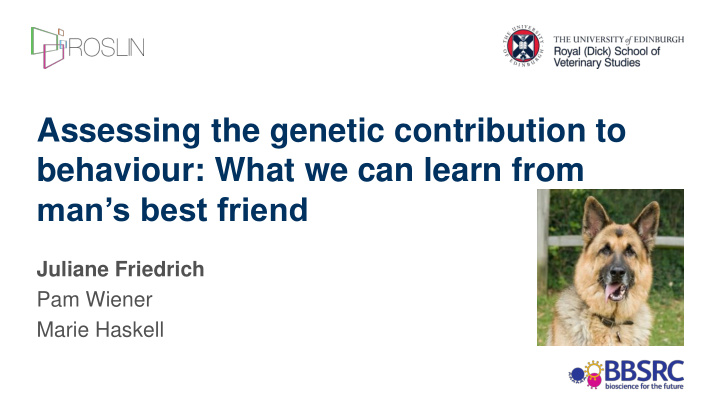



Assessing the genetic contribution to behaviour: What we can learn from man’s best friend Juliane Friedrich Pam Wiener Marie Haskell
Domestication of the dog: a “long -term selection experiment” Belyaev’s “Farm fox experiment”: selection for • tameness in Silver foxes resulted in significant behavioural and morphological changes (Trut, 1999) Domestication of dogs 14,000 years ago → start point for intense selection on • different traits, e.g. behaviour Dog = interesting resource on the genetic architecture of behaviour variation •
The dog as powerful animal model for genetic analyses • Structure of canid genome: higher LD compared to humans • Intense artificial selection generated diverse phenotypes (including behaviour) • Informative pedigrees • Resemblance of many diseases between dogs and humans • Shared coexistence with humans (e.g. environment, diet, stressors)
Aims Identify genetic variation associated with behavioural characteristics Identify signatures of selection for behaviour by artificial selection (recent) Can dogs provide general insights into behaviour? What is the role of selection for behaviour diversification?
Association study: DATA & METHODS • Phenotype data: – C-BARQ (Canine Behavioral Assessment & Research Questionnaire) – 13 behaviour characteristics, e.g. on aggression, fearfulness, trainability, playfulness • German Shepherd dogs (GSDs): – – Pet, show & working Pet, show & working dogs dogs – – Random sample of Selected for the UK GSD behaviour (test of population the Swedish Armed Forces)
Association study: DATA & METHODS • Genotype data: – 741 GSDs genotyped with Illumina Canine HD Beadchip (173,662 SNPs) → 78,088 SNPs after QC • Statistical analyses: – Heritability (h 2 ) estimates (pedigree & genomic information) – Genome-wide association study (GWAS) & Regional-heritability mapping (RHM)
Association study: RESULTS h 2 Behaviour trait Pedigree-based Genome-based Stranger-directed aggression Dog-directed aggression Stranger-directed fear 0.04 ± 0.05 0.04 ± 0.05 Human-directed playfulness 0.23 ± 0.08 0.17 ± 0.07 Excitability 0.05 ± 0.05 0.06 ± 0.05 Separation anxiety Lack of obedience Stranger-directed interest 0.10 ± 0.06 0.01 ± 0.05 Attachment/ Attention seeking 0.02 ± 0.05 Chasing 0.09 ± 0.06 0.13 ± 0.06 Non-social fear 0.12 ± 0.06 0.16 ± 0.06 Dog-directed fear 0.01 ± 0.04 Touch sensitivity 0.02 ± 0.04
Association study: RESULTS Human-directed playfulness GWAS RHM
Association study: RESULTS ► GO analysis of the top 0.5% significance SNPs for Human-directed playfulness (n= 394; 202 genes) Panther pathway P-value Heterotrimeric G-protein signaling pathway-Gi alpha and Gs 0.01 alpha mediated pathway Metabotropic glutamate receptor group III pathway 0.02 Heterotrimeric G-protein signaling pathway-Gq alpha and Go 0.02 alpha mediated pathway PDGF signaling pathway 0.03 Axon guidance mediated by Slit/Robo 0.01
Progressing from genetic associations to signatures of selection for behaviour ► Human-directed playfulness as ► Human-directed playfulness differs promising trait: between populations: • moderate h 2 • significant SNPs
Progressing from genetic associations to signatures of selection for behaviour ► Human-directed playfulness as ► Human-directed playfulness differs promising trait: between populations: • moderate h 2 • significant SNPs Dissecting genetic architecture of behaviour using selection signals
Selection signatures: DATA & METHODS vs. – – Random sample of Selected for behaviour the UK GSD (test of the Swedish Armed population Forces) • Analyses: – Genomic population structure (PCA, ADMIXTURE) – Within populations: integrated Haplotype score (iHS) – Between populations: Difference between ROH (|H-score|), F ST , XP-EHH
Selection signatures: RESULTS Genomic population structure
Selection signatures: RESULTS Genomic population structure
Selection signatures: RESULTS Within populations RAB3GAP1 DARS Mutations in RAB3GAP1 are associated with neurologic diseases in different dog breeds • (Mhlanga-Mutangadura et al. 2016) Impaired attentional processing in DARS +/− mice (Froehlich et al. 2017) •
Selection signatures: RESULTS Within populations GABRA1 GABRA1 is strong candidate gene for personality and anxiety across species • Candidate gene for epilepsy in dogs (Ekenstedt et al. 2011) • Differential expression in dogs after exposure to chronic stress (Luo et al. 2015) •
Selection signatures: RESULTS |H score| Between populations XP-EHH F ST
Selection signatures: RESULTS |H score| Between populations XP-EHH F ST FGF5 BMP3 PRKG2 RASGEF1B
Selection signatures: RESULTS Between populations ► GO analysis of the top 1% consensus SNPs (n= 391; 141 genes) Panther pathway P-value |H score| p53 pathway feedback loops 2 1.07E-02 774 TGF-beta signalling pathway 6.64E-02 156 193 8 F ST XP-EHH B cell activation 9.63E-02 891 846 34 Oxidative stress response 1.01E-01 Parkinson disease 1.01E-01
Summary & conclusions • Evidence for genetic variation of behavioural characteristics within dogs • Human-directed playfulness shows potential for selection and might reflect the domestication history of the dog • Identified candidate genes previously linked to psychological disorders or behaviours in other species highlight the dog as model animal • Dog as promising resource to analyse behavioural selection
Thanks to… Pam Wiener Enrique Sánchez-Molano Owners of German Shepherd Ricardo Pong-Wong dogs participating in this study Andrea Talenti UK Kennel Club Marie Haskell British Association for German Shepherd Dogs Erling Strandberg Per Arvelius German Shepherd Dog Breed Susanne Gustafsson Council of Great Britain Gabriela Bottani Claros
Haplotype analysis for multiple significant SNPs located in genes Candidate genes were previously linked to neurodevelopmental disorders ( TLK2 ) and autism in humans • ( LRRN3, DIAPH3) and to aggressive behaviour in mice ( NRXN1 ) KCNQ knock-out mice showed an increased sensitivity of mechanoreceptors in the skin (Schütze et al., 2016) Touch-sensitivity variation in KCNAB1 (also encoding a potassium channel) could have a similar effect in dogs
Recommend
More recommend